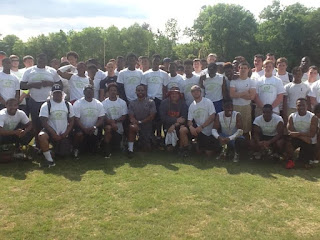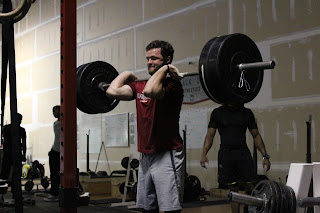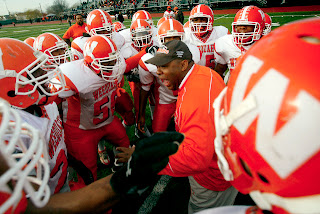Is the weight room helping or hurting
you during the season?
1 1. Manage outside stressors
The body does not know the difference between a weight, practice, long
night of studying, or lack of nutrition. It just knows that the body is
stressed and adjustments need to be made. We believe in holding our athletes
accountable for their lives outside the field or weight room. Our sheet holds
the athletes accountable for sleeping 8 hours a night, eating for performance,
managing stressors, stretching, and staying hydrated. Feel free to email us to
receive a copy of our M.A.P (Mental Advantage Plan) regeneration sheet.
2 2. Program Design
We structure weight room with activity that will not add soreness to the
athlete. We do not change the exercises around during the in season, so the
body will not get sore while being introduced to a new stimulus. We do not load
the back as much during the season as many athletes compress the spine during
collisions in the game. We prefer the Front Squat to a Box, Zercher Squat to a
Box, or Trap Bar Deadlift. Also, our rep ranges are in the 3-5 area as we are
trying to maintain or gain some strength. You do not want to work all summer
and throw all the strength you earned away during the season. It will
strengthen your bones and help maintain the efficiency of your central nervous
system. A big mistake that athletes make during the season is to lift the same
way they did during the offseason. For instance, they take weight training
where they lift 5 days a week. We lift two times a week during the season. Our
workouts end 2 days prior to the game as we believe that the body and the
central nervous system must recuperate to have a successful game day. We lift
the day after the game for regeneration purposes. We want to pump as much blood
into the body as possible to help heal the muscle trauma from the game. These
workouts are low intensity; time based, and include a circuit style of
training. We also include some box jumping during the season as that is low
impact, but still develops the stretch reflex for the power needed for the
game. We enjoy medicine ball throws in place of Olympic lifts as that takes
pressure of the wrists. They get enough use during the games. We train different positions differently as
well as athletes that do not play as much. For instance, our QB’s are required
to perform 100 band pull aparts daily to counteract the amount of internal
rotation they perform during throwing. Also, we do not stay in the weight room
past 40 minutes. Practices take precedent during the season and the weight room
is part of our general preparation to keep us resilient.
3 3. We sprint
 Some Coaches feel like they do enough running during practices, but most
of what I see is conditioning. When you run in a state of fatigue you will not improve
your speed. Also, speed is a skill, so going a long time without exposure will
help you become detrained. Every year out athletes come back slower than we sent
them to their HS teams. The key is not overdo it…we do no more than 3 all our
sprints with full recovery. Also, the distances are short as the hamstring is
already taxed during practices with running plays. We do quite a bit of form
running at low intensities to reinforce form, so we do not have to teach it as
much when the players start off season training.
Some Coaches feel like they do enough running during practices, but most
of what I see is conditioning. When you run in a state of fatigue you will not improve
your speed. Also, speed is a skill, so going a long time without exposure will
help you become detrained. Every year out athletes come back slower than we sent
them to their HS teams. The key is not overdo it…we do no more than 3 all our
sprints with full recovery. Also, the distances are short as the hamstring is
already taxed during practices with running plays. We do quite a bit of form
running at low intensities to reinforce form, so we do not have to teach it as
much when the players start off season training.
4. Eating for performance
If you are not getting enough protein in during the day you will not
repair muscle that is broken down during practice. The last thing we need is to
lose muscle during the season. We recommend 1 g per bodyweight in lbs. A 180
lb. athlete would take in 180 grams of protein a day. We know most athletes
will not eat that in whole food such chicken, beef, eggs, etc…Our favorite
protein power is Dymatize 100% Whey protein 2-3 times a day. Also, when
athletes are eating fried foods they are just slowing down the healing process.
Those foods are not anti-inflammatory like fish oil and vegetables.
5
5.Recovery is key
You are only as good as what you can adapt to and recover from. We recommend
doing Cryotherapy after the game. We also foam roll during training sessions
and we activate ourselves through a breathing/stick technique. It activates all
the muscles that need to be awaken to perform at your best. Also, players are encouraged
to use the Sauna, cold bath, salt bath, and stem treatment to speed up the
recovery process.
Jimmy Lamour is a
former Guilford College in Greensboro, NC All South Defensive Back. He set the
record for interception return yards at the school. Upon Graduation, he tested
numerous philosophies on strength and speed through seminars, self-study, conversation with renowned
strength coaches, and training of hundreds of athletes. This led him to develop
the 4.30 40 Speed System a system that helped him improve his 40 yard dash from
a 4.66 to a 4.30, which gave way to many professional football workouts. He
later developed Lamour Training Systems with the help of his lovely wife
Charlene to help athletes improve their performance and receive knowledge he
missed out on as a child. He continues to consult with several division 1, prep
schools, and high school coaches. LTS has helped many football athletes play at
the D1, D2, and D3 levels. He believes that his passion to see young men become
all God intended them to be and provide knowledge of the defensive back
position which will allow young athletes under the tutelage of Pick 6 Academy
to flourish. He is currently certified as a Youth Fitness specialist, 7on7
Performance Director, and High School Strength & Conditioning Specialist.
Also, Coach Lamour is a devout Christian and enjoys being a part of Harvest
Church. He has two children Camdon (19) and Micah (12).Sign up for his
newsletter to receive his free speed report at http://fastyouthathlete.blogspot.com/ on For more information, call 336-257-9151








Comments
Post a Comment